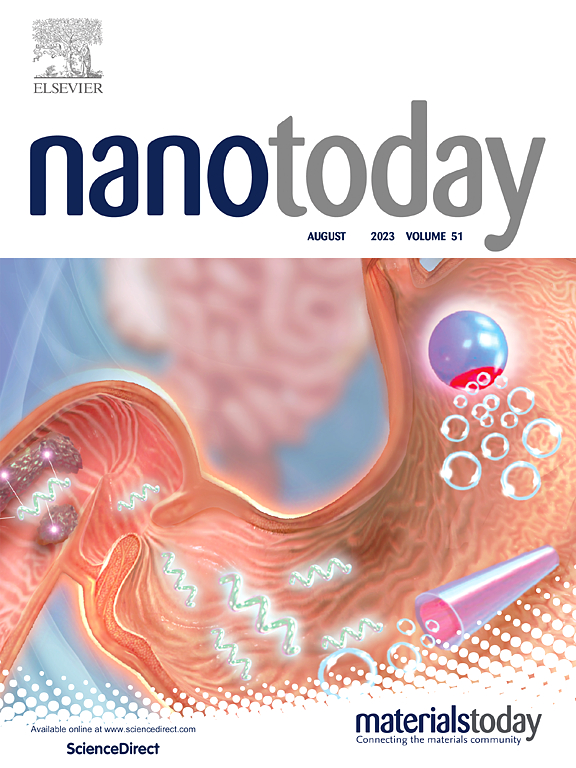过氧化氢酶和一氧化氮的仿生纳米反应器可增强过氧化亚硝酸盐的生成,从而提高辐射敏感性
IF 13.2
1区 材料科学
Q1 CHEMISTRY, MULTIDISCIPLINARY
引用次数: 0
摘要
肿瘤中冗余的DNA修复能力和强大的缺氧能力给癌症放疗带来了巨大挑战。本文合成了一种两亲性一氧化氮(NO)供应共轭物(PEG-SMA-NO),并将其与产氧过氧化氢酶(CAT)结合,制成了一种仿生纳米反应器(CAT@PNN),旨在增强X射线辐射时过氧亚硝酸盐的生成,从而实现放射增敏。CAT@PNN能有效降低肿瘤的缺氧水平,并产生丰富的NO分子。在X射线照射下,过氧化亚硝酸自由基的生成具有深刻的时空分布特征,可有效下调DNA修复RAD51的表达,降低癌干细胞的比例,并提高DNA损伤、细胞凋亡和脂质过氧化的水平,从而帮助放射增敏。具体而言,在 4T1 肿瘤模型中,将 CAT@PNN 与 X 射线辐射结合使用,可使肿瘤生长抑制率达到 95.41%,并显著延长存活时间。因此,CAT@PNN 的仿生纳米反应器为提高癌症放疗的放射增敏提供了一个前景广阔的过亚硝酸盐生成纳米平台。本文章由计算机程序翻译,如有差异,请以英文原文为准。
Biomimetic nanoreactor of catalase and nitric oxide enhance peroxynitrite generation for radiosensitization
The redundant DNA-repairing capacity and robust hypoxia in tumors pose significant challenges of cancer radiotherapy. Herein, an amphiphilic nitric oxide (NO)-supplying conjugate (PEG−SMA−NO) was synthesized and integrated with oxygen-producing catalase (CAT) to fabricate a biomimetic nanoreactor (termed as CAT@PNN), aiming to enhance peroxynitrite generation upon X-ray radiation for radiosensitization. CAT@PNN effectively reduced the hypoxic levels and produced abundant NO molecules in tumors. Upon X-ray radiation, excessive peroxynitrite radicals were generated with profound spatiotemporal distribution profiles, which effectively downregulated the expression of DNA-repairing RAD51, reduced the proportion of cancer-stem like cells, and enhanced the levels of DNA damages, cell apoptosis and lipid peroxidation to aid radiosensitization. Specifically, the combination of single treatment of CAT@PNN with X-ray radiation resulted in a 95.41 % inhibition of tumor growth and significantly extended survival in 4T1 tumor model. Therefore, the biomimetic nanoreactor of CAT@PNN offers a promising peroxynitrite-generating nanoplatform to enhance radiosensitization in cancer radiotherapy.
求助全文
通过发布文献求助,成功后即可免费获取论文全文。
去求助
来源期刊

Nano Today
工程技术-材料科学:综合
CiteScore
21.50
自引率
3.40%
发文量
305
审稿时长
40 days
期刊介绍:
Nano Today is a journal dedicated to publishing influential and innovative work in the field of nanoscience and technology. It covers a wide range of subject areas including biomaterials, materials chemistry, materials science, chemistry, bioengineering, biochemistry, genetics and molecular biology, engineering, and nanotechnology. The journal considers articles that inform readers about the latest research, breakthroughs, and topical issues in these fields. It provides comprehensive coverage through a mixture of peer-reviewed articles, research news, and information on key developments. Nano Today is abstracted and indexed in Science Citation Index, Ei Compendex, Embase, Scopus, and INSPEC.
 求助内容:
求助内容: 应助结果提醒方式:
应助结果提醒方式:


